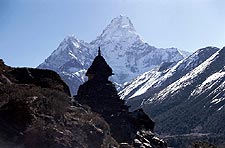 A slice of Himalayan heaven: a temple sits amid the rock and ice of Nepal’s upper elevations
A slice of Himalayan heaven: a temple sits amid the rock and ice of Nepal’s upper elevations Q: I was planning a river-rafting trip to Nepal, but I wonder if it makes sense to go, considering the recent terrorist attacks and likely U.S. retaliation. Would it be foolhardy to travel right now?
— Abigail Levine
Burlington, Vermont
���ϳԹ��� Advisor:
A: By definition, adventure travelers have always straddled a line between personal safety and personal freedom. There’s inherent risk in everything we do, from paddling into rapids to the less obvious danger of riding a rickety bus home from the take-out. Since September 11, we’ve come to realize that we are vulnerable in ways we had never before imagined. But deciding how much risk is acceptable remains a very personal matter.
The first bit of advice I can give is that you make as informed a decision as possible. The best resources available are the U.S. State Department’s travel advisory Web page (), your outfitter, and the U.S. Embassy in Kathmandu (), tel. 411179; for a listing of U.S. embassy offices worldwide, go to .
The most recent warning for Nepal by the State Department is a September 13 announcement cautioning Americans to avoid demonstrations in Kathmandu by the increasingly vocal Maoist insurgents. The Maoists, who have waged a guerilla war against the government since 1995, escalated their attacks last fall and then again in June following the massacre of the royal family. The good news is that the violence has abated following an August cease-fire, and, for now, the peace process moves forward, albeit rather unconvincingly. Keep in mind that even if the Maoists renew their attacks on government forces, they’ve so far largely ignored tourists except for a few instances where guerilla soldiers have pressed trekking groups for “donations.”
As for general adventure travel concerns as the U.S. organizes a global coalition to respond to the terrorist attacks, the State Department warns that American citizens living or traveling abroad may be at increased risk of terrorist attacks and recommends, among other things, that you keep a low profile (i.e., leave your “I-heart-USA” T-shirt at home) and pay attention to what’s going on around you (i.e., it’s best to avoid any large, angry-looking mobs). Not terribly helpful information.
Given that Afghanistan will seemingly be the focus point of any U.S.-led retaliation, it would be prudent to postpone visits there and also think long and hard before joining a trip to that country’s Central Asian neighbors. Kyrgyzstan, Uzbekistan, Kurdistan, Tajikistan, and Pakistan offer some remarkable climbing and other adventure possibilities but aren’t the most cautious destination choices at present.
Regardless of where you’re heading, you might consider purchasing a flexible plane ticket that allows you to change plans at the last minute without a major penalty. You can also ask your travel agent about inexpensive travel insurance that will cover your expenses should you need to get back home in a hurry.
Maybe it will help you to know that I’m tossing around the same concerns right now. My husband and I are planning a winter surf trip to Indonesia — another country with an active advisory from the State Department. And while I admit that we’ve got one eye on the news and the other on our plane tickets, we have agreed to let informed, rational decisions — and not fear — dictate our travel plans. Giving up on adventure and exploration altogether would grant the terrorists a victory they most certainly don’t deserve.


